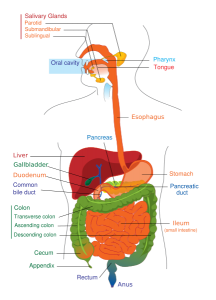
It is a highly specialized organ that is designed to do three very important things: convert food into something your cells can use for nourishment and then absorb it; protect you from invading organisms and toxins; and dispose of a large variety of waste products. It is truly amazing that these three vital functions are performed by one structure.
This tube is so specialized that it actually has its own nervous system, often called a second brain. It also has a significant defense system to protect it from outside threats; in fact, the largest part of our immune system resides in the lining of the digestive tract. And to top it all off, this tube contains a highly evolved ecosystem of organisms which are not only critical to proper digestive function, but which are also a vital part of the defense system. You can start to see that a problem in the digestive tract has the potential to indeed be a very big problem.
Food moves down the tube by an involuntary process called peristalsis, a wavelike muscular contraction that carries the nutrients from top to bottom. This movement is controlled by the digestive tract’s private nervous system.
Technically, anything inside this tube is not really inside your body. Only once it has been processed and broken down does it pass through the tissue wall of the tube. This tissue wall is a permeable “skin,” similar in many respects to the one that protects you on your other exterior surfaces – the skin of your arms and legs, torso and face. Like your outer skin, the tube’s tissue wall is protective, however, it is highly specialized for digestion and absorption.
The food breaks down into a number of substances as it moves down the tube in stages. Muscular valves close off portions of the tube while chemical processes are carried out at each stage. Different areas absorb different vitamins, nutrients, minerals, and even water. Substances necessary for digestion and absorption, including acids and enzymes, are secreted into different sections of the tube. Waste is also created at each step and moves down the tube toward the exit. All of these functions are highly coordinated, working together to provide you with proper nutrition and to protect you from harm.

Dr. Wangen is the founder and medical director of the IBS Treatment Center, the award winning author of two books, and a nationally recognized speaker on digestive disorders. He has been on ABC, NBC, and Fox as well as public radio, and was named one of Seattle’s Top Doctors by Seattle Magazine.

